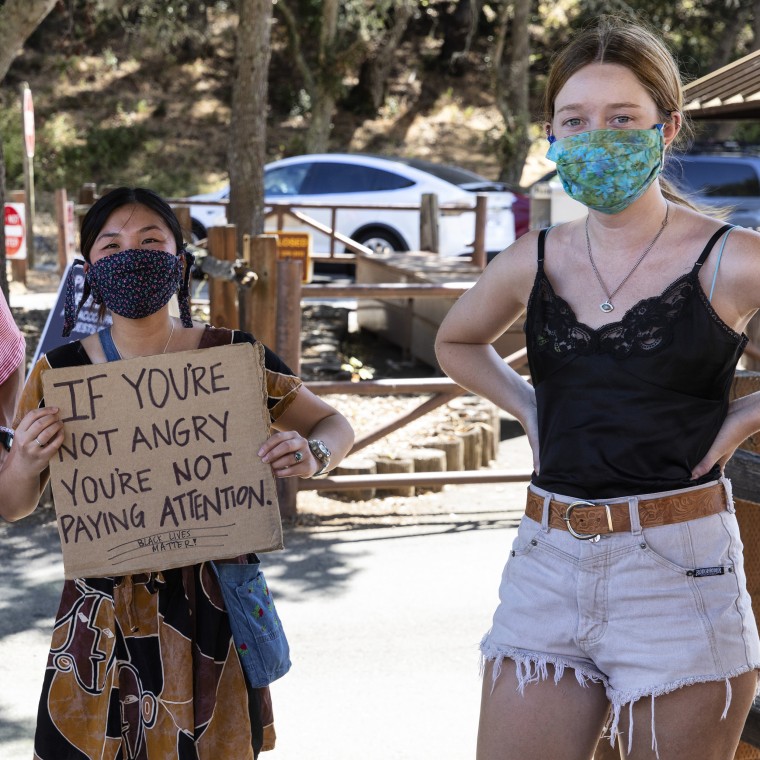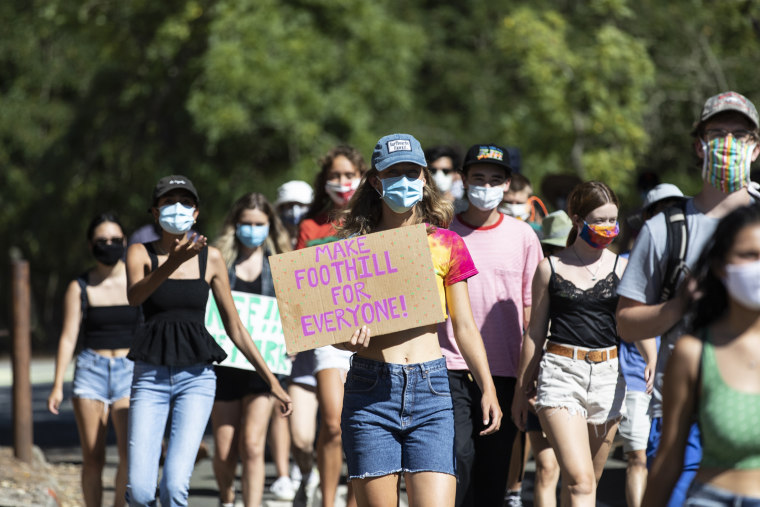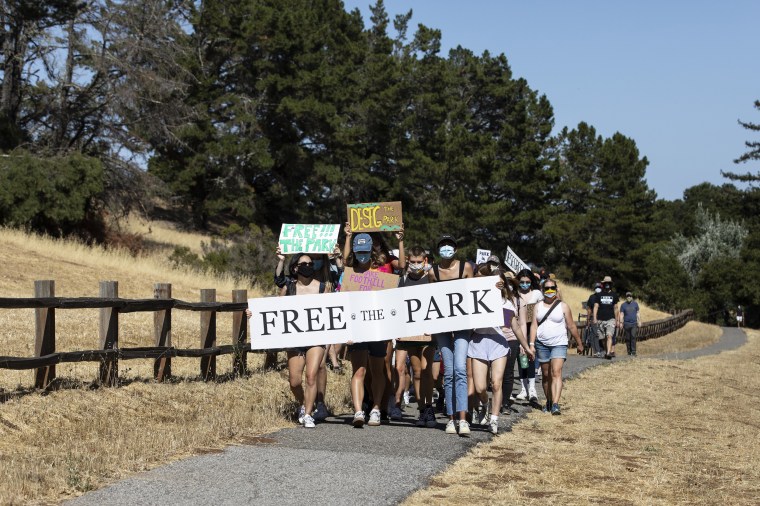For people in Northern California, Foothills Park may be the perfect getaway spot. The pristine area has a lake and trails spread across 1,400 acres, nearly twice the size of New York City’s Central Park, and it’s a short drive from the sprawling headquarters of companies such as Apple and Google.
But its most striking feature may be what it takes to get in: proof you live in Palo Alto, a city where houses tend to run about $3 million and a two-bedroom apartment rents for $3,700 on average.
Foothills Park is a city-owned park that homeowners have fought for decades to keep closed to outsiders. A sign out front reads “residents and accompanied guests only,” and rangers check IDs at the park's entrance, turning away about 3,100 vehicles a year that don’t qualify. Breaking the rule is a misdemeanor, although the city said it hasn’t charged anyone for the crime in at least 20 years.
Now, a debate over the municipal code is boiling over, with new attention from Black Lives Matter demonstrators, civil rights lawyers and people who live in neighboring towns who argue the restrictions on a public space reek of racism and segregation.
“You don’t see that many black and brown faces in Foothills Park,” Anjali Ramanathan, 17, said. She and her family live within walking distance of the preserve but can’t legally go on their own because they live on the other side of the city line.

Ramanathan, who has helped organize protests at the park this summer, said the policy contradicts Palo Alto’s worldwide reputation for innovation and freethinking.
“They are folks who I’m sure pat themselves on the back as liberals and nonracists,” she said. “The true test of someone’s commitment to combating racial inequality is what they’re willing to give up of their own.”
Examples of inequality in America are coming under attack as civil rights demonstrations, the coronavirus pandemic and the recession have revealed starkly different realities based on class and race.
Since June, activists have painted “desegregate” in large letters at the entrance to Foothills Park, and Ryan McCauley, a member of the Palo Alto Parks and Recreation Commission, resigned over the city’s refusal to budge, saying the current policy “crudely discriminates by address and ZIP code.” Proponents of change said they’re preparing a lawsuit.
The protesters have included members of the Raging Grannies, a political group that has also held demonstrations against Facebook. And one supporter of opening the park even wrote a folk song for the cause, borrowing the melody from “This Land Is Your Land” and adding satirical lyrics to lampoon the status quo.
“This park is my park / It is not your park,” former Palo Alto Mayor Leland Levy sang during a virtual comment period before the City Council. “This park was meant for only me.”
A letter to the city urging a change was signed by more than 130 supporters, including local ministers and rabbis, the American Civil Liberties Union of Northern California, the local NAACP chapter and Regina Wallace Jones, the mayor of East Palo Alto, a majority-minority city adjacent to Palo Alto.
The local congresswoman, Democratic Rep. Anna Eshoo, who can’t legally visit the park because she lives in a nearby town, signed the letter. So did some faculty and students from neighboring Stanford University, where on-campus residents live outside the city limits of Palo Alto.

Residents who like the park the way it is are promising a fierce response. Many have lived in Palo Alto for decades, having moved there during earlier tech booms.
Palo Alto acquired the land for the park in 1959 and opened the park in 1965. The residency requirement came in 1969, after other nearby towns declined to help pay for the land or upkeep.
“I do NOT want Foothills Park opened to the general public,” a petition circulated by Carlin Otto, a resident and former Cisco employee, reads. “I value its quiet, its uncrowdedness, its pristine condition, the opportunities to see wildlife. More people in the Park will degrade all of these. I pay my taxes to keep it in this condition!!”
Otto wrote in an email to the City Council that she feared the change would be forced down residents’ throats. “Remember, we the residents of Palo Alto are the owners of Foothills Preserve and Park, not you,” she wrote to council members.
In one survey by a City Council member, a majority of respondents said they even favored keeping illegal entry a misdemeanor-level crime rather than reducing it to an infraction.
Similar debates are playing out elsewhere, including on the beaches of Connecticut. The debates pit suburban homeowner prerogatives against a rising demand for outdoor space due to the coronavirus pandemic, mixed with calls for racial justice after the killing of George Floyd.
Advocates for opening Foothills Parks said it’s the only example of a publicly owned, residents-only park in California, a state that generally embraces public access to open spaces. About 20 miles west of Foothills Park, the state is locked in a decadelong legal fight with tech billionaire Vinod Khosla over access to a beach next to his property.
A city of 65,000 people, Palo Alto is 60 percent white and 33 percent Asian. Only 1.6 percent of residents are Black and 5.7 percent are Hispanic, according to census data. And civil rights advocates say that segregation is largely by design because Palo Alto residents have made it difficult or impossible for Black and Latino people to buy homes there.
Meanwhile, the median sale price of a home in Palo Alto was $3 million in July, according to the Silicon Valley Association of Realtors.
LaDoris Cordell, a former judge who previously served on the Palo Alto City Council, said the restrictions at Foothills Park are an expression of racism past and present.
“They see the browning of America, and they’re concerned. They don’t want to see things change,” Cordell, who is Black, said. “It’s so racist to me, and so elitist. So privileged and so full of white supremacist thinking.”
She said that although there’s a Black Lives Matter mural on a street in front of city hall, “I have said to them, ‘Your words do not match your actions.’”
Cordell, who moved to Palo Alto to attend law school at Stanford University in the 1970s and stayed, is among those preparing a lawsuit against the city. She said they expect to file in the next several weeks.
Similar lawsuits in other wealthy enclaves have led to varied outcomes. In 2001, the Connecticut Supreme Court struck down a residents-only policy at a beach in Greenwich, ruling that the space qualified as a public forum under the First Amendment. But in 2014, the Nevada Supreme Court let stand a residents-only beach policy at Lake Tahoe.
Tom DuBois, a Palo Alto City Council member, said he does not believe racism is motivating the opponents of change.
“I really don’t think any of this is race-based,” he said, citing the city’s large Asian minority. “It’s about monitoring the usage of the park.”
Park attendance, though, has fallen far from its peak of 372,000 annual visitors in the early 1970s. Around 152,000 people visited in recent years, and according to city data, at no time in the past 20 years has the park reached its current cap of 1,000 visitors at a time.
The park rules go into meticulous detail to limit even accompanied guests. Weddings and other events are allowed, but there must be one Palo Alto resident for every 15 nonresidents.
Keeping it sparse appeals to some residents. “I’m not against opening it. I’m against trashing the park,” Irina Beylin said. She and her husband both work in tech and have lived in Palo Alto since 1991.
Beylin said the discussion has been “huge” on Nextdoor, a social media app where she estimated 9 out of 10 people want to keep the park as is. She said race isn’t a factor. “It’s strange when people bring up ‘you’re racist’ when you don’t want people to come,” she said.
Tech executives don’t seem to be weighing in. Palo Alto’s most famous resident, Facebook CEO Mark Zuckerberg, hasn’t taken a public stance on the park debate, and a spokesman declined to comment.
The issue nearly came to a head early this month, when the city council voted 5-2 in favor of a pilot program that, at least in theory, would allow a limited number of nonresidents to enter after buying permits.
But that vote was preliminary and contained what may amount to a poison pill: the pilot program must pay for itself, so it would need to collect enough money in fees to pay for an environmental study, a website to issue permits and additional staff. There’s no plan yet to do that.
“I do not believe that they’re going to do anything,” Cordell said. “I believe we will get this park open in the courts.”
The two dissenting votes were the members who pushed most strongly to open the park, including Mayor Adrian Fine. A native of the city, he has warned Palo Alto is “becoming a wealthy retirement town,” opposed to affordable housing or any other change.
“I’m always amazed at Palo Alto’s ability to miss an opportunity,” Fine said after the vote. “We’re literally discriminating against nonresidents because they’re not wealthy enough to live in Palo Alto.”
